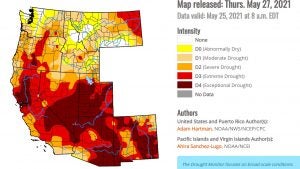For those of us in agriculture, we realize that Mother Nature will always have a say in our industry. You can plan out every detail of a growing season, but often it is a waste of time since no one knows what type of weather we will face in a given season. That is exactly what is happening to farmers and ranchers out west.

The current drought conditions in the Western United States is causing havoc for farmers, ranchers, and community members. For example, in California, farmers and ranchers are making tough decisions on how to continue this growing season knowing there is already a water shortage — and that it is likely to continue this summer.
Below, you can see that some almond growers already had to decide to tear up their almond orchards due to the plant’s high water needs. In exchange for almonds, producers can instead grow a lower water-demanding crop in an effort to save their water resources.
View this post on Instagram
So far these decisions have not resulted in a shortage in almonds. In fact, this was actually supposed to be a record-breaking year for almonds, according to the U.S. Department of Agriculture. Almond growers are on high alert over the current water situation.
“What we’re seeing with this report is a forecasted continuance of high yields,” said Richard Waycott, president and CEO of the Almond Board of California. “Water availability will be the principal concern on growers’ minds as they continue to grow this crop.”
View this post on Instagram
According to The Weather Channel, the current drought is one of the most expansive U.S. droughts this century and isn’t going any where soon. A portion of the issue stems from the lack of spring snow to recharge the state’s reservoirs. According to Peter Gleick, water and climate scientist at the Pacific Institute, the warm weather left the snowpack virtually gone by late May, about two months earlier than average. For example, Lake Oroville (pictured above) was less than half its average level for late May.
View this post on Instagram
The situation is so dire that California Gov. Gavin Newsom expanded a drought emergency proclamation in May. In total, 41 counties — out of 58 — are now under a drought state of emergency, representing 30 percent of the state’s population. Additionally, Newsom proposed a $5.1 billion package of immediate drought response and long-term water resilience investments.
Unfortunately, we are just now heading into California’s “dry season,” so the opportunity of seeing any relief is dwindling. According to The Weather Channel, San Francisco picks up 91 percent of its average rainfall from November through April. However, a new study published by the USDA’s Agricultural Research Service and the University of Arizona suggest dry periods between rainstorms have become longer and annual rainfall has become more erratic across most of the western United States during the past 50 years.
View this post on Instagram
There is no denying that California and much of the Western United States has been affected by a lack of rain and water resources for many years now. These images have truly shown the awful condition that California and surrounding states are currently dealing with. If this trend continues, farmers and ranchers will have to adjust their operations and continue to make hard decision.


